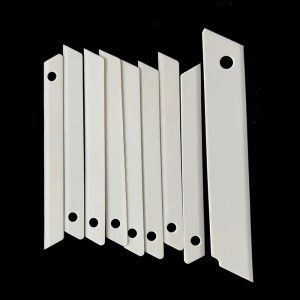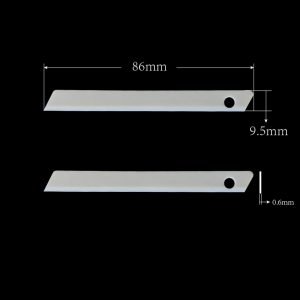
Ceramic utility blades offer several advantages and functions compared to traditional steel blades. Some of these advantages include:
1. Sharpness: Ceramic blades are incredibly sharp and can maintain their edge for a longer time compared to steel blades. They are made from very hard materials like zirconium oxide, which allows for excellent cutting performance.
2. Durability: Despite being extremely sharp, ceramic blades are also quite durable. They resist wear, corrosion, and rust, making them ideal for various cutting applications.
3. Chemical Resistance: Ceramic blades are non-reactive to most chemicals, acids, and alkalis, which makes them suitable for use in industries or environments where exposure to such substances is common.
4. Lightweight: Ceramic blades are typically lighter than steel blades, which can reduce fatigue during extended use.
5. Non-conductive: They do not conduct electricity or heat, making them safer to use in certain situations, such as electrical work.
6. Precision Cutting: Due to their sharpness and hardness, ceramic blades are excellent for precision cutting tasks that require fine details and accuracy.
7. Reduced Maintenance: Ceramic blades often require less maintenance compared to steel blades. They do not need frequent sharpening, which can save time and effort.

Functions of ceramic utility blades:
1. Industrial Applications: Ceramic blades are used in various industrial applications where precise cutting of materials like paper, cardboard, plastic, and thin materials is required. They find utility in industries such as packaging, electronics, textiles, and more.
2. Crafts and Hobbies: Ceramic blades are popular among hobbyists and craftsmen for tasks like model making, scrapbooking, and other intricate crafting where precision cutting is essential.
3. Medical Field: In the medical field, ceramic blades are used for surgical purposes due to their sharpness and non-reactivity with bodily fluids and tissues.
4. Kitchen Tools: Ceramic blades are also used in kitchen knives. They retain sharpness for longer periods compared to steel knives and are non-reactive with food, making them suitable for slicing fruits, vegetables, and boneless meats.
While ceramic utility blades offer numerous advantages, they may be more brittle compared to steel blades and are prone to chipping or breaking if used improperly or against hard materials. It’s essential to use them for their intended purposes and handle them with care to prevent damage.

